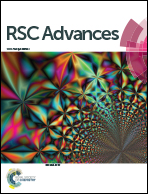Morphology and carrier non-geminate recombination dynamics regulated by solvent additive in polymer/fullerene solar cells†
Abstract
In this study, PBDTTT-E (based on benzo [1,2-b:4,5-b′] dithiophene (BDT) and thieno [3,4-b] thiophene (TT)) as a donor and fullerene derivative PC71BM (phenyl-C71-butyric acid methyl ester) as an acceptor with and without 1,8-diiodooctane (DIO)-treated copolymer solar cells were investigated. The device based on PBDTTT-E with treated DIO showed remarkably high current density (Jsc), fill factor (FF) and similar open-circuit voltage (Voc). Charge carrier lifetime (τn), density (n) and non-geminate recombination rate (krec) in the photoactive layers were measured by employing transient photovoltage (TPV) and charge extraction (CE) techniques. Based on krec and n, J–V curves were reconstructed. The DIO optimized the morphology of the active layer and its PBDTTT-E:PC71BM interfaces were increased. Therefore, compared to the device without the treated DIO, the device with the treated DIO showed larger electron mobility, longer carrier lifetime (τn) and lower non-geminate recombination rate (krec), which enhances the carrier transport and restrains the non-geminate recombination, realizing the higher Jsc and FF. In addition, that the DIO-treated devices can weaken the role of other factors (such as field dependent geminate recombination) in limiting device performance. The results provide some hints of improved device performance upon DIO as an additive in the D–A type polymer/fullerene solar cells.



 Please wait while we load your content...
Please wait while we load your content...